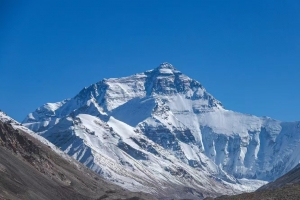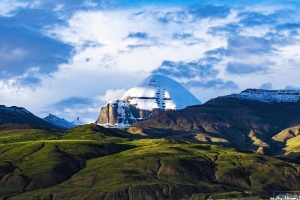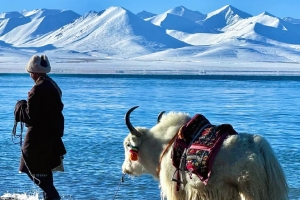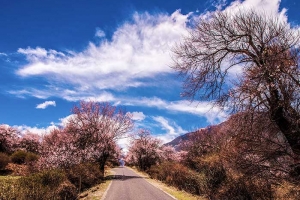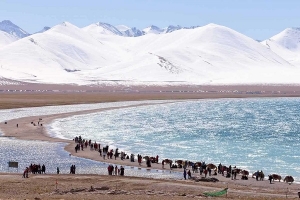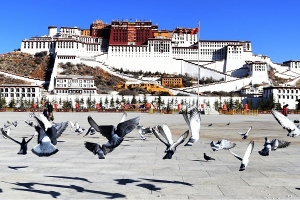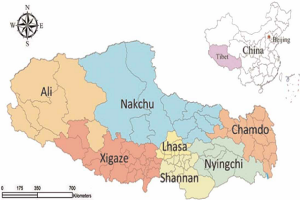Lhasa, the capital city of the Tibet, is not just a political hub—it is a living museum where ancient traditions, awe-inspiring landscapes, and vibrant spiritual energy converge. Known as ལྷ་ས in Tibetan, which translates to “The Land of the Gods” or “Holy Place,” Lhasa captivates visitors with its mystical allure and centuries-old legacy. Founded in 633 A.D. by the visionary Tibetan King Songtsen Gampo, Lhasa has grown from a modest settlement into a thriving metropolis that continues to inspire pilgrims, historians, and travelers alike.
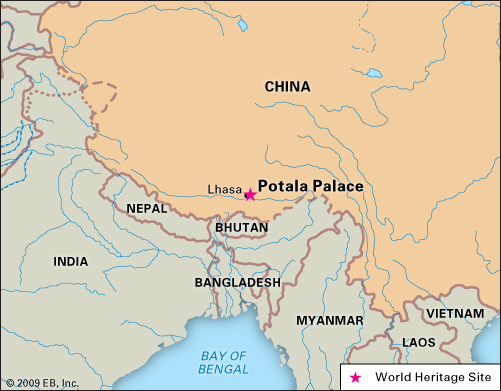
Lhasa’s Origins and Legacy
Lhasa’s history spans more than 1,300 years, making it one of the oldest continuously inhabited cities in Asia. The city’s founding by King Songtsen Gampo marked the beginning of a cultural renaissance that would forever change the Tibetan Plateau. As a unifier of diverse tribes and cultures, King Songtsen Gampo is credited with establishing not only a strong centralized state but also with laying the foundations of Tibetan Buddhism.
Over the centuries, Lhasa evolved into a center for art, literature, and spiritual practice. Its ancient streets whisper tales of past glories and conquests, while its sacred temples and palaces stand as monuments to a deeply rooted religious heritage. Today, Lhasa’s architectural gems—such as the Jokhang Temple, Potala Palace, and Norbulingka—offer visitors a window into an era where spirituality and governance were intertwined.
The city’s historical narrative is enriched by the evolution of its religious institutions. Monasteries like Sera and Drepung, once bustling with thousands of monks, were not merely places of worship but also centers of learning and philosophical debate. These institutions played an essential role in the propagation of Buddhist teachings, attracting scholars and pilgrims from across Asia. The legacy of King Songtsen Gampo and his successors continues to influence Tibetan culture, making Lhasa a symbol of resilience and enduring spiritual power.
The Spiritual Heartbeat of Lhasa
Lhasa’s soul is deeply intertwined with Tibetan Buddhism, and its landmarks are living embodiments of this faith. Pilgrims and tourists alike are drawn to the city to experience its sacred atmosphere and to witness the rituals that have been performed here for centuries.
Jokhang Temple: The Spiritual Epicenter
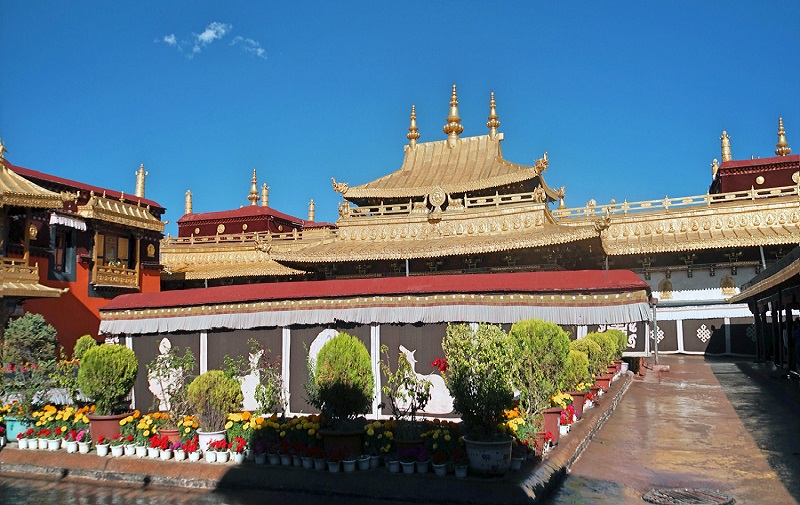
At the heart of Lhasa lies the Jokhang Temple, established in the 7th century. Revered as the most sacred temple in Tibet, Jokhang is the spiritual nucleus of the city. Pilgrims undertake a traditional circumambulation, known as kora, around the temple and along the bustling Barkhor Street that encircles it. This ancient path is lined with stalls selling Tibetan handicrafts, prayer wheels, and ritual objects, all of which add to the vibrant tapestry of local life.
The Jokhang Temple houses a revered statue said to have been consecrated by Shakyamuni Buddha himself. This sacred icon, which depicts the Buddha at a young age, is believed to embody the eternal spirit of Tibetan Buddhism. The temple’s four-tiered structure is a remarkable example of early Tibetan architecture, and its golden roof remains visible from nearly every corner of the Old Town—a constant reminder of its historical significance.
Potala Palace: A Majestic Fortress in the Sky
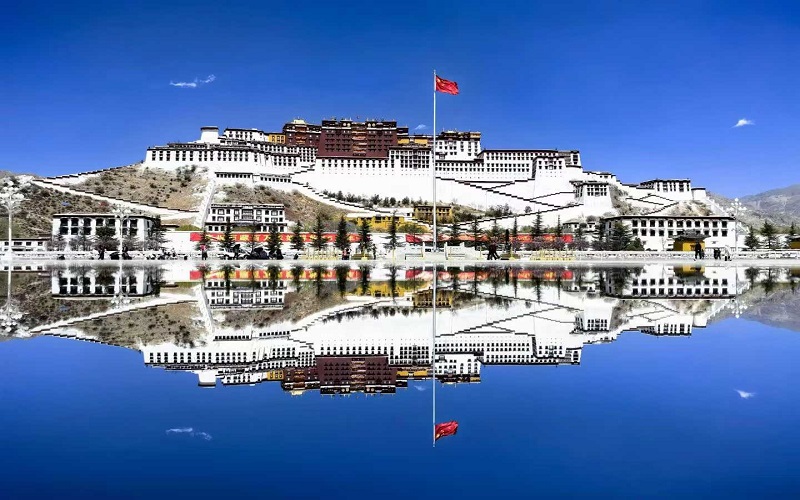
No visit to Lhasa would be complete without a pilgrimage to the Potala Palace. Once the winter residence of the Dalai Lama, the Potala Palace looms majestically over the city from its perch atop Marpo Ri Hill. Its colossal, multi-storied structure, adorned with intricate murals and ancient artifacts, speaks of an era when the palace served as the heart of Tibetan governance and spirituality.
Walking through its vast halls and corridors, visitors can almost feel the weight of centuries of history. The palace’s architecture is a fascinating blend of Tibetan design and Buddhist symbolism, and every room tells a story of the Dalai Lama’s spiritual journey and the city’s historical transformation. Photographs of the Potala Palace have graced currency notes and postcards, symbolizing its status as an emblem of Tibetan identity.
Norbulingka: The Jewel Park
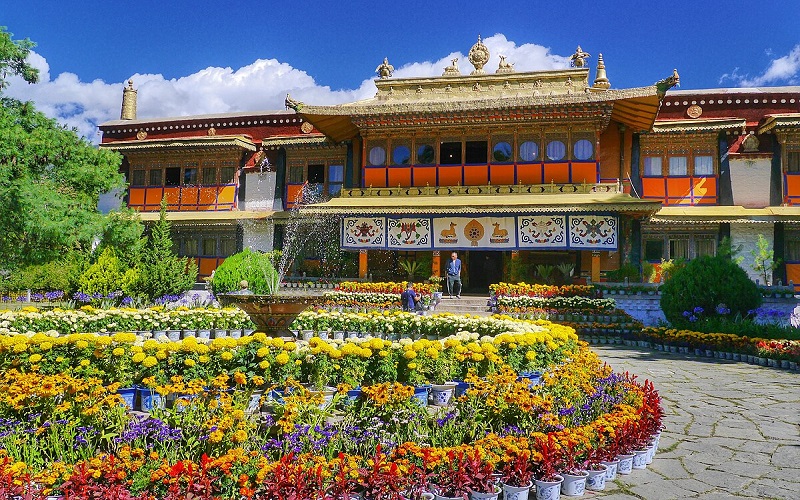
Often referred to as the “Jewel Park,” Norbulingka was the summer residence of the Dalai Lamas. Unlike the imposing fortresses of other landmarks, Norbulingka exudes a tranquil, garden-like charm. Spread over lush grounds with blooming flowers, meandering streams, and serene lakes, this historical park offers a peaceful retreat from the bustle of Lhasa.
Here, traditional Tibetan palaces blend harmoniously with natural beauty. The park is a favored spot during the Shoton Festival—a time when locals and visitors gather to enjoy picnics, cultural performances, and the vibrant atmosphere of Tibetan celebrations. Norbulingka’s serene environment provides a perfect counterbalance to the dynamic energy found in Lhasa’s more crowded areas.
Monasteries and Nunneries: Guardians of Tradition

In addition to its major landmarks, Lhasa is dotted with a plethora of monasteries and nunneries, each contributing uniquely to the city’s spiritual mosaic. The Sera and Drepung monasteries, once home to thousands of monks, continue to be centers of scholarly debate and spiritual practice. At Sera, you can witness lively discussions among monks—a tradition that highlights the rigorous intellectual and spiritual training in Tibetan Buddhism.
Smaller nunneries, such as Ani Tsamkhong, offer a more intimate look at religious life in Lhasa. These establishments not only serve as sanctuaries for spiritual practice but also as hubs for community service. For example, many nunneries operate tea houses and traditional Tibetan hospitals, playing a crucial role in the social fabric of the city. These sacred institutions, often hidden away from the typical tourist trail, provide an authentic glimpse into the everyday lives of Tibetan devotees.
Geography and Altitude of Lhasa
Lhasa’s unique geography plays a significant role in its allure. The city is nestled in the picturesque Kyichu River valley, surrounded by towering mountain ranges that create a dramatic and ever-changing skyline. This stunning natural setting not only enhances Lhasa’s beauty but also imbues it with a sense of isolation and mysticism.
A City at 3,656 Meters
At an altitude of 3,656 meters (11,995 feet) above sea level, Lhasa is one of the highest capital cities in the world. This lofty elevation means that the air is thinner, and visitors may experience mild symptoms of altitude sickness upon arrival. Common effects include headaches, shortness of breath, and fatigue, especially during the first few days of acclimatization.
For many travelers, this challenge is part of the adventure. The high altitude also makes Lhasa an ideal starting point for those interested in exploring the higher reaches of Tibet. With a few days of rest and gradual acclimatization, visitors can comfortably venture into more remote and elevated regions of the Tibetan Plateau. To ease the transition, it is advisable to stay hydrated, avoid excessive physical exertion upon arrival, and, if necessary, consult a healthcare provider before embarking on a high-altitude journey.
Climate and Seasonal Variations

Despite its extreme elevation, Lhasa boasts a surprisingly pleasant climate. The city benefits from over 3,000 hours of sunshine per year, earning it the reputation of a “sunlit city.” The weather is characterized by significant diurnal temperature variations, meaning that while daytime temperatures can be warm—even in summer—nights can be considerably cooler.
Summertime in Lhasa is marked by long, sunlit days with occasional rain showers, especially during the monsoon season from late June to early September. These sporadic rains usually occur at night, ensuring that daytime explorations remain largely uninterrupted. The warm days provide ample opportunity to enjoy outdoor activities, from wandering through ancient streets to hiking in the surrounding hills.
Winter in Lhasa is a study in contrasts. Although the mornings and evenings can be brisk and chilly, daytime temperatures are generally moderate, often hovering around +10°C (50°F). Unlike many other high-altitude locations, Lhasa experiences relatively mild winters with minimal snowfall in the urban center. This season, though quieter in terms of tourist activity, offers a unique perspective on traditional Tibetan life, with local markets and religious practices continuing amidst the crisp air.
The best time to visit Lhasa is typically from April to mid-October, when the weather is most accommodating for sightseeing and outdoor activities. However, for those interested in a more tranquil experience, winter visits provide an opportunity to explore the city with fewer crowds and a more intimate connection to its cultural rhythms.
Practical Travel Information: Navigating Lhasa
Lhasa’s status as the political, cultural, and economic center of Tibet means that it is well-equipped with modern amenities and transportation networks. Whether you’re an intrepid backpacker or a seasoned traveler, getting to and around Lhasa is an adventure in itself.
By Air: Lhasa Gonggar Airport
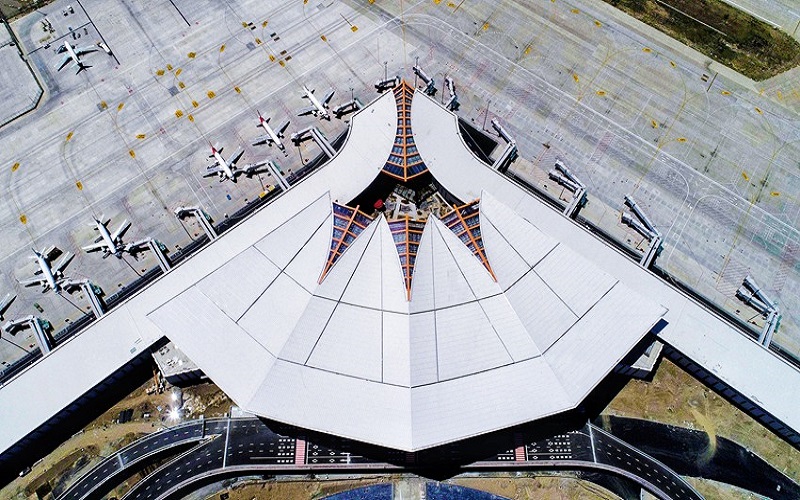
Lhasa Gonggar Airport is the main international gateway to the Tibetan capital. Located approximately 62 kilometers (39 miles) from the city center, this airport is one of the highest in the world, surrounded by majestic mountain peaks that add to the sense of entering an otherworldly landscape. The airport handles a range of domestic flights connecting Lhasa with major cities across China, as well as international flights—most notably from Kathmandu, Nepal—making it accessible to global travelers.
The journey from the airport to the heart of Lhasa typically takes around an hour by car. Most visitors opt to arrange a transfer through their tour operator, ensuring a smooth and comfortable introduction to the city’s unique environment.
By Train: The Qinghai-Tibet Railway

For those seeking a more scenic route, the Qinghai-Tibet Railway offers an unforgettable experience. This engineering marvel traverses some of the most remote and breathtaking landscapes in the world, gradually ascending to Lhasa while providing panoramic views of rugged mountains, vast plateaus, and shimmering lakes. Traveling by train not only allows passengers to acclimatize gradually to the high altitude but also provides ample opportunities to capture the natural beauty of the region through a series of unforgettable vistas.
Tickets for the Qinghai-Tibet Railway can be in high demand, particularly during peak tourist seasons, so it is advisable to book well in advance. The journey itself has become a significant part of the Tibetan travel experience, with soft sleeper accommodations ensuring a comfortable ride even as the scenery changes dramatically with every mile.
Overland Routes: A Land of Scenic Highways
For the adventurous at heart, overland travel to Lhasa is another popular option. Modern highways connect Lhasa with neighboring regions such as Qinghai, Sichuan, Yunnan, Xinjiang, and even Nepal. Road trips offer an immersive experience of the diverse landscapes of Tibet, from verdant valleys to stark, rugged mountains. Popular routes include journeys from Chengdu—via both southern and northern corridors—Xining, and from Kathmandu through the Gyirong border near the base of Mount Everest.
Overland travel allows for spontaneous stops in remote villages, traditional markets, and lesser-known temples, enriching the overall experience with unexpected encounters and authentic cultural exchanges.
Immersive Cultural Experiences in Lhasa
While the ancient monuments and majestic landscapes form the backbone of Lhasa’s allure, the city’s vibrant local culture is what truly brings it to life. Visitors have the opportunity to engage directly with Tibetan traditions, whether through culinary experiences, local festivals, or interactions with the resident population.
Wander Through Barkhor Street
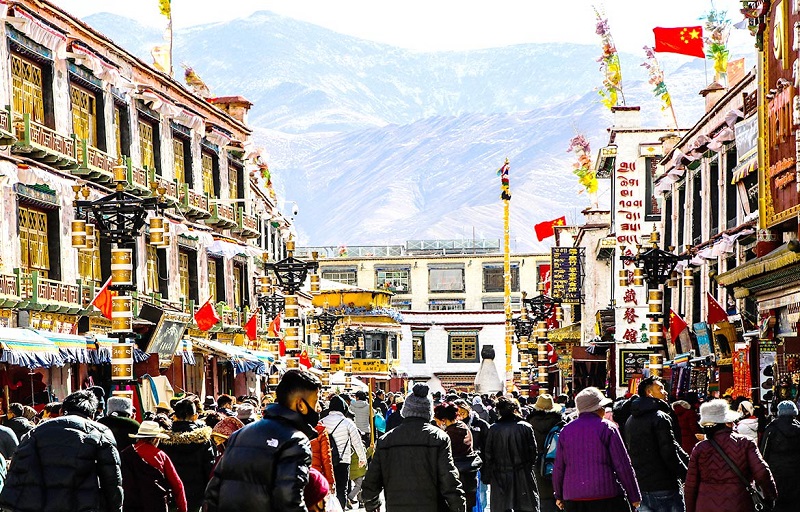
Barkhor Street is more than just a marketplace—it is the lifeline of Old Lhasa. Stretching in a circular route around the Jokhang Temple, this bustling thoroughfare is lined with stalls selling everything from hand-woven Tibetan fabrics and silver jewelry to prayer flags and religious talismans. As you navigate the narrow alleys, you will encounter locals engaged in lively trade, children chasing each other around ancient courtyards, and elderly residents quietly recounting tales of a bygone era. This vibrant street offers a truly immersive experience in Tibetan daily life, where every turn reveals a new facet of local tradition.
Savor the Flavors of Tibetan Cuisine
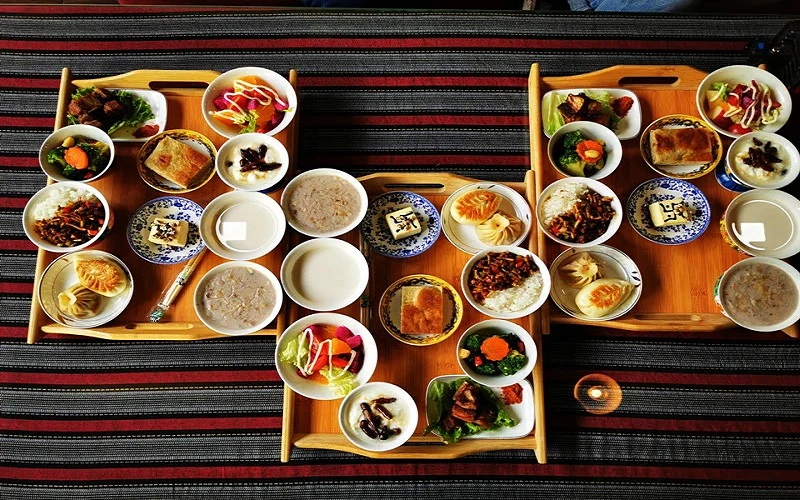
Tibetan cuisine is a reflection of the region’s harsh climate and nomadic heritage. Meals are hearty, designed to provide warmth and sustenance in high-altitude conditions. Signature dishes include tsampa (roasted barley flour), momos (Tibetan dumplings), and thukpa (noodle soup). Local tea houses offer a cozy refuge where you can sample these traditional dishes while enjoying a cup of butter tea—a Tibetan staple known for its rich, savory flavor.
Dining in Lhasa is an experience that transcends mere nourishment; it is an invitation to partake in centuries-old culinary traditions. Many restaurants now offer both authentic Tibetan fare and international cuisines, with outdoor terraces that provide panoramic views of the city’s ancient rooftops and majestic mountains.
Celebrations, Festivals, and Local Life
Lhasa is also the stage for numerous cultural festivals that highlight the rich tapestry of Tibetan life. The Shoton Festival, for example, transforms the city into a living canvas of music, dance, and art. During this festival, locals and visitors gather in parks and public spaces to celebrate through traditional performances, theatrical operas, and spirited communal feasts.
In addition to festivals, everyday life in Lhasa offers countless opportunities to witness the enduring traditions of Tibetan culture. Whether you’re visiting a local monastery to observe a morning prayer ritual or simply enjoying a leisurely walk along the riverbanks at sunset, the city invites you to slow down and savor its timeless rhythms.
Is It Safe to Travel in Lhasa?
Traveling to high-altitude destinations like Lhasa comes with its own set of challenges, particularly for those unaccustomed to thinner air. However, with the right precautions, most visitors find that the transition is manageable and that the experience is both safe and rewarding.
Adjusting to High Altitude
The high elevation of Lhasa can cause mild altitude sickness in some travelers. Common symptoms include headache, fatigue, and shortness of breath. These symptoms are usually temporary and can be alleviated by taking it slow upon arrival. Here are some practical tips:
- Hydrate Frequently: Drinking plenty of water is essential for helping your body adjust to the lower oxygen levels.
- Rest Upon Arrival: Allow yourself a couple of days to acclimatize before engaging in strenuous activities or long hikes.
- Monitor Your Health: If symptoms persist or worsen, consult a local healthcare provider. Many tour operators in Lhasa are well-prepared with oxygen and medical supplies to assist visitors.
- Avoid Alcohol and Smoking: These substances can exacerbate symptoms of altitude sickness and hinder your body’s ability to adapt.
A Safe Destination for Tourists
Lhasa is widely regarded as a safe destination for travelers. The city welcomes millions of visitors each year, and local authorities, along with registered travel agencies, ensure that all necessary permits and local guides are provided to enhance both safety and the cultural experience. By planning your trip through reputable agencies, you can ensure that your journey is not only enriching but also secure.
The Role of Lhasa in Contemporary Tibet
While steeped in ancient tradition, Lhasa has not remained frozen in time. Modern developments have subtly woven themselves into the fabric of the city, creating a unique juxtaposition between the old and the new.
A Hub of Cultural Revival
Recent years have seen a cultural revival in Lhasa, with renewed efforts to preserve and promote Tibetan art, music, and literature. Galleries and cultural centers now complement the city’s historical sites, hosting exhibitions that celebrate both traditional and contemporary Tibetan creativity. This fusion of old and new provides a dynamic cultural landscape where ancient rituals coexist with modern artistic expressions.
Sustainable Tourism and Preservation
As tourism in Lhasa continues to grow, local authorities and cultural organizations are increasingly focused on preserving the city’s heritage. Sustainable tourism practices are being implemented to ensure that the influx of visitors does not compromise the integrity of historical sites or disrupt local life. Initiatives include guided tours led by knowledgeable local experts, community-based tourism projects, and conservation efforts aimed at maintaining the city’s architectural and cultural treasures.
Economic and Social Development
Lhasa’s growth as a major tourism destination has also spurred broader economic and social development within the region. Modern amenities, improved transportation infrastructure, and new hospitality services have emerged to cater to both domestic and international travelers. Despite these developments, Lhasa has managed to retain its unique character—a balance between progress and the preservation of its sacred traditions.
Embracing the Spirit of Lhasa with Journey2tibet
Lhasa is more than just a city—it is a living embodiment of Tibetan identity, where every stone, every prayer wheel, and every mural tells a story of a people deeply connected to their past. From its founding by King Songtsen Gampo to its present-day role as a spiritual and cultural beacon, Lhasa offers an unparalleled journey through history, religion, and natural beauty.
For travelers seeking a destination that offers both profound cultural insights and breathtaking natural scenery, Lhasa stands as a testament to the enduring spirit of Tibet. Prepare to immerse yourself in a world where ancient rituals meet modern life, where every moment is an opportunity to connect with history, and where the land of the gods beckons you to discover its timeless mysteries.


